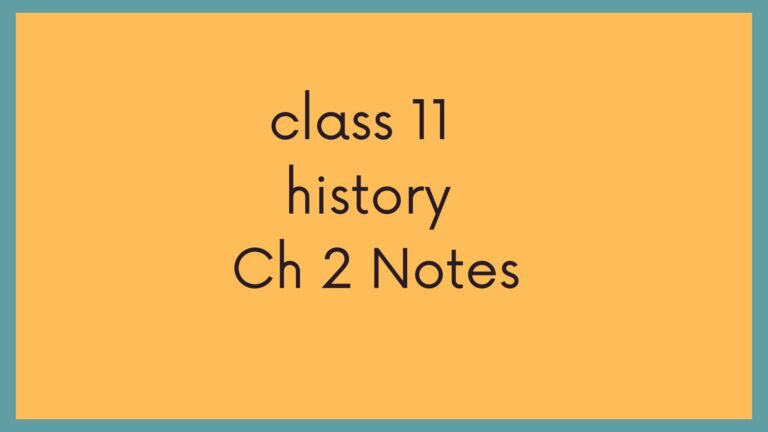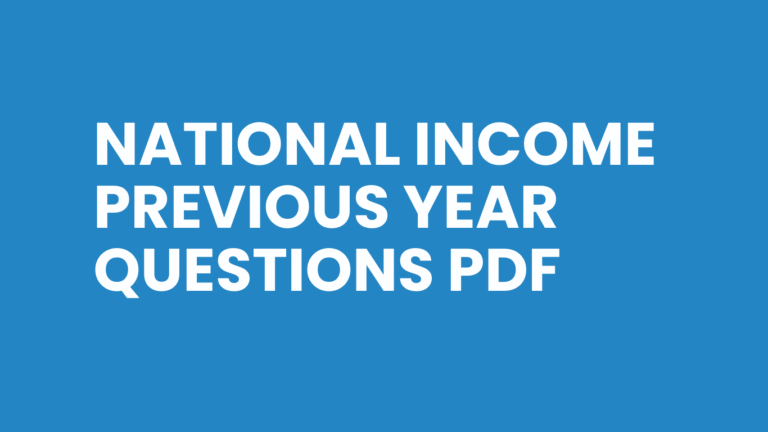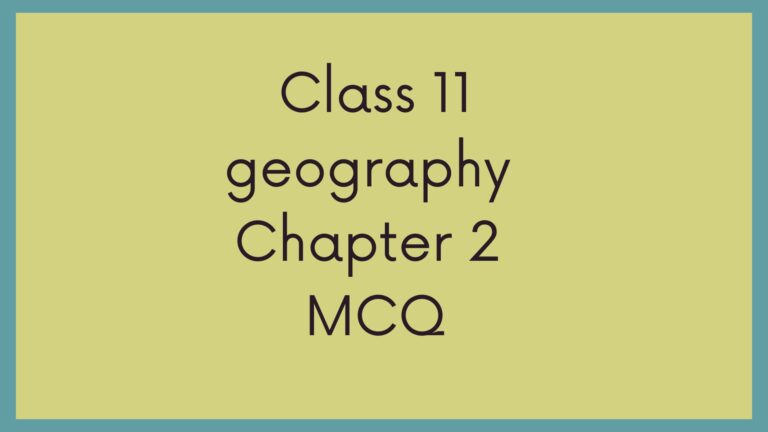CUET Geography Most Important MCQ | Geography MCQ for CUET 2026
This article will provide you with CUET Geography Most Important MCQ. Geography MCQ for CUET 2026 can help you score good marks and get into the top college that you are aiming for. I myself have scored very good marks in CUET using these MCQs and have provided all these based on my experience.
CUET Geography Most Important MCQs are very easy to understand and are completely based on the strict NTA exam pattern. The questions are of high quality and well-designed. You can get the explanation on our YouTube Channel.

Top 50 CUET Geography Most Important MCQ
Q1. Who said ‘Human geography is the study of the changing relationship between the unresting man and the unstable earth’?
A) Ratzel
B) Ellen C. Semple
C) Paul Vidal
D) Griffith Taylor
Answer: B) Ellen C. Semple
Chapter: Chapter 1: Human Geography – Nature and Scope
Q2. Which approach to human geography was followed during the colonial period?
A) Areal differentiation
B) Spatial organization
C) Behavioural
D) Regional
Answer: D) Regional
Chapter: Chapter 1: Human Geography – Nature and Scope
Q3. Which school of thought employed Marxian theory to explain poverty and social inequality?
A) Welfare
B) Radical
C) Behavioural
D) Quantitative
Answer: B) Radical
Chapter: Chapter 1: Human Geography – Nature and Scope
Q4. What is the present growth rate of world population?
A) 1.0%
B) 1.2%
C) 1.4%
D) 1.6%
Answer: B) 1.2%
Chapter: Chapter 2: The World Population Distribution, Density and Growth
Q5. Which continent has the highest population density?
A) Africa
B) Asia
C) Europe
D) North America
Answer: B) Asia
Chapter: Chapter 2: The World Population Distribution, Density and Growth
Q6. How many countries constitute 60% of world’s population?
A) 6
B) 8
C) 10
D) 12
Answer: C) 10
Chapter: Chapter 2: The World Population Distribution, Density and Growth
Q7. Which is the second most populous country in the world?
A) China
B) India
C) USA
D) Indonesia
Answer: B) India
Chapter: Chapter 2: The World Population Distribution, Density and Growth
Q8. The dependency ratio indicates the relationship between:
A) Working and non-working population
B) Male and female population
C) Urban and rural population
D) Literate and illiterate population
Answer: A) Working and non-working population
Chapter: Chapter 3: Population Composition
Q9. Which age group is considered economically active?
A) 0-14 years
B) 15-59 years
C) 60+ years
D) 0-59 years
Answer: B) 15-59 years
Chapter: Chapter 3: Population Composition
Q10. The Human Development Index (HDI) is published by:
A) World Bank
B) UNDP
C) IMF
D) WHO
Answer: B) UNDP
Chapter: Chapter 4: Human Development
Q11. Which of the following is NOT a component of HDI?
A) Life expectancy
B) Education
C) Per capita income
D) Employment rate
Answer: D) Employment rate
Chapter: Chapter 4: Human Development
Q12. Which is the oldest economic activity of humans?
A) Fishing
B) Gathering
C) Farming
D) Hunting
Answer: B) Gathering
Chapter: Chapter 5: Primary Activities
Q13. Transhumance is associated with:
A) Mining
B) Nomadic herding
C) Manufacturing
D) Trading
Answer: B) Nomadic herding
Chapter: Chapter 5: Primary Activities
Q14. Which crop is NOT a plantation crop?
A) Coffee
B) Sugarcane
C) Wheat
D) Rubber
Answer: C) Wheat
Chapter: Chapter 5: Primary Activities
Q15. Cooperative farming was most successful in:
A) Russia
B) Denmark
C) India
D) Netherlands
Answer: B) Denmark
Chapter: Chapter 5: Primary Activities
Q16. Which type of industry produces raw materials for other industries?
A) Cottage industry
B) Small scale industry
C) Basic industry
D) Footloose industry
Answer: C) Basic industry
Chapter: Chapter 6: Secondary Activities
Q17. Silicon Valley is located near:
A) Montreal
B) San Francisco
C) Bangalore
D) Gurugram
Answer: B) San Francisco
Chapter: Chapter 6: Secondary Activities
Q18. Which industry is NOT a footloose industry?
A) Electronics
B) Software
C) Steel
D) Textiles
Answer: C) Steel
Chapter: Chapter 6: Secondary Activities
Q19. Medical tourism is an example of:
A) Primary activity
B) Secondary activity
C) Tertiary activity
D) Quaternary activity
Answer: C) Tertiary activity
Chapter: Chapter 7: Tertiary and Quaternary Activities
Q20. Which is a quaternary activity?
A) Teaching
B) Research
C) Banking
D) Trading
Answer: B) Research
Chapter: Chapter 7: Tertiary and Quaternary Activities
Q21. Which mode of transport provides door-to-door service?
A) Rail
B) Road
C) Airways
D) Pipelines
Answer: B) Road
Chapter: Chapter 8: Transport and Communication
Q22. The Suez Canal was constructed in:
A) 1849
B) 1859
C) 1869
D) 1879
Answer: C) 1869
Chapter: Chapter 8: Transport and Communication
Q23. Panama Canal connects which two seas?
A) Atlantic and Indian
B) Pacific and Indian
C) Atlantic and Pacific
D) Mediterranean and Red Sea
Answer: C) Atlantic and Pacific
Chapter: Chapter 8: Transport and Communication
Q24. The difference between exports and imports is called:
A) Trade surplus
B) Trade deficit
C) Balance of trade
D) Terms of trade
Answer: C) Balance of trade
Chapter: Chapter 9: International Trade
Q25. World Trade Organization (WTO) was established in:
A) 1991
B) 1995
C) 1999
D) 2000
Answer: B) 1995
Chapter: Chapter 9: International Trade
Q26. India’s population as per 2011 census is:
A) 1028 million
B) 1182 million
C) 1210 million
D) 1350 million
Answer: C) 1210 million
Chapter: Chapter 1: Population – Distribution, Density, Growth and Composition (India)
Q27. Which state has the highest population in India?
A) Maharashtra
B) Uttar Pradesh
C) Bihar
D) West Bengal
Answer: B) Uttar Pradesh
Chapter: Chapter 1: Population – Distribution, Density, Growth and Composition (India)
Q28. Which state has the highest population density in India?
A) West Bengal
B) Kerala
C) Uttar Pradesh
D) Bihar
Answer: D) Bihar
Chapter: Chapter 1: Population – Distribution, Density, Growth and Composition (India)
Q29. The average density of population in India (2011) is per sq km:
A) 324
B) 382
C) 421
D) 464
Answer: B) 382
Chapter: Chapter 1: Population – Distribution, Density, Growth and Composition (India)
Q30. The main reason for male migration in India is:
A) Education
B) Marriage
C) Work and employment
D) Business
Answer: C) Work and employment
Chapter: Chapter 2: Migration – Types, Causes and Consequences
Q31. The main reason for female migration in India is:
A) Education
B) Marriage
C) Work and employment
D) Business
Answer: B) Marriage
Chapter: Chapter 2: Migration – Types, Causes and Consequences
Q32. Which state has the highest HDI in India?
A) Kerala
B) Goa
C) Punjab
D) Himachal Pradesh
Answer: A) Kerala
Chapter: Chapter 3: Human Development (India)
Q33. Which state has the highest proportion of urban population in India?
A) Maharashtra
B) Tamil Nadu
C) Gujarat
D) Goa
Answer: D) Goa
Chapter: Chapter 4: Human Settlements
Q34. A settlement with population between 1000-5000 is called:
A) Hamlet
B) Village
C) Town
D) City
Answer: B) Village
Chapter: Chapter 4: Human Settlements
Q35. Which type of soil is most suitable for cotton cultivation?
A) Alluvial soil
B) Black soil
C) Red soil
D) Laterite soil
Answer: B) Black soil
Chapter: Chapter 5: Land Resources and Agriculture
Q36. Green Revolution in India started in:
A) 1960s
B) 1970s
C) 1980s
D) 1990s
Answer: A) 1960s
Chapter: Chapter 5: Land Resources and Agriculture
Q37. Which state is the largest producer of rice in India?
A) Punjab
B) Haryana
C) West Bengal
D) Uttar Pradesh
Answer: C) West Bengal
Chapter: Chapter 5: Land Resources and Agriculture
Q38. Which river has the largest drainage basin in India?
A) Ganga
B) Godavari
C) Krishna
D) Brahmaputra
Answer: A) Ganga
Chapter: Chapter 6: Water Resources
Q39. Bhakra Nangal project is built on river:
A) Ganga
B) Yamuna
C) Sutlej
D) Chenab
Answer: C) Sutlej
Chapter: Chapter 6: Water Resources
Q40. Which state is the largest producer of coal in India?
A) Jharkhand
B) Chhattisgarh
C) Odisha
D) West Bengal
Answer: B) Chhattisgarh
Chapter: Chapter 7: Mineral and Energy Resources
Q41. Kudremukh is famous for:
A) Coal mining
B) Iron ore mining
C) Gold mining
D) Copper mining
Answer: B) Iron ore mining
Chapter: Chapter 7: Mineral and Energy Resources
Q42. Which city is known as the ‘Silicon Valley of India’?
A) Mumbai
B) Chennai
C) Bangalore
D) Hyderabad
Answer: C) Bangalore
Chapter: Chapter 8: Manufacturing Industries
Q43. Tata Iron and Steel Company (TISCO) is located at:
A) Bhilai
B) Bokaro
C) Jamshedpur
D) Durgapur
Answer: C) Jamshedpur
Chapter: Chapter 8: Manufacturing Industries
Q44. The first Five Year Plan of India was launched in:
A) 1947
B) 1950
C) 1951
D) 1952
Answer: C) 1951
Chapter: Chapter 9: Planning and Sustainable Development in Indian Context
Q45. Sustainable development aims at:
A) Economic growth
B) Environmental protection
C) Social equity
D) All of the above
Answer: D) All of the above
Chapter: Chapter 9: Planning and Sustainable Development in Indian Context
Q46. Which is the longest National Highway in India?
A) NH-1
B) NH-2
C) NH-7
D) NH-8
Answer: C) NH-7
Chapter: Chapter 10: Transport and Communication (India)
Q47. The first railway line in India was opened in:
A) 1853
B) 1856
C) 1860
D) 1863
Answer: A) 1853
Chapter: Chapter 10: Transport and Communication (India)
Q48. Golden Quadrilateral connects which cities?
A) Delhi-Mumbai-Chennai-Kolkata
B) Delhi-Mumbai-Bangalore-Chennai
C) Mumbai-Chennai-Kolkata-Ahmadabad
D) Delhi-Kolkata-Chennai-Mumbai
Answer: A) Delhi-Mumbai-Chennai-Kolkata
Chapter: Chapter 10: Transport and Communication (India)
Q49. India’s largest trading partner is:
A) USA
B) China
C) UAE
D) Germany
Answer: B) China
Chapter: Chapter 11: International Trade (India)
Q50. Which of the following is a major environmental problem in India?
A) Air pollution
B) Water pollution
C) Soil erosion
D) All of the above
Answer: D) All of the above
Chapter: Chapter 12: Geographical Perspective on Selected Issues and Problems
ALSO CHECK – CUET History MCQ Practice And PDF | CUET 2026 Best History MCQ






